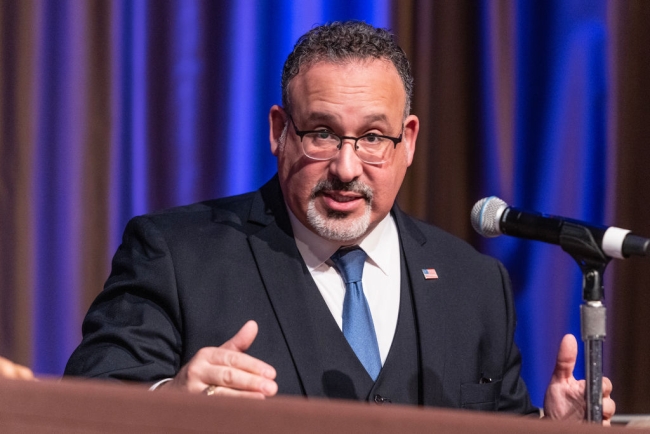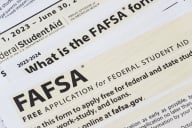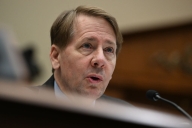You have /5 articles left.
Sign up for a free account or log in.

“Too many students are getting ripped off,” Education Secretary Miguel Cardona said. A new, stronger gainful-employment rule is aimed at better protecting students from ending up with unaffordable student debt.
Lev Radin/Pacific Press/LightRocket via Getty Images
About 5 percent of programs required to prepare their graduates for gainful employment would fail the Biden administration’s new rule, Education Department data released Wednesday evening show. The affected programs, many of which are at for-profit institutions, risk losing federal financial aid.
The Biden administration released its long-awaited gainful-employment rule Wednesday evening as part of a 1,000-page package of regulations that also includes rules on financial responsibility, administrative capability, certified procedures and ability to benefit. The rule is similar to what the administration proposed last year during negotiated rule making; it requires programs to show that graduates can afford their yearly debt payments and that they are making more than an adult who didn’t go to college.
The department said the gainful-employment rule would protect more than 703,000 students per year “from attending these failing career training programs.” The regulations apply to programs at for-profit institutions as well as nondegree programs in any sector.
“Today the Department of Education is proposing the strongest protections against unaffordable college debt in history,” Secretary Miguel Cardona said during a press briefing. “Investing in a college degree or career certificate is supposed to pay off. Instead, too many students are getting ripped off.”
The rule, he said, would help ensure that the country has a higher education system that’s affordable and accountable to students. The department wants to create a new website that will track a range of data on all college programs—not just those covered by gainful employment. That website would include new information on the program costs, student debt and earnings of completers, among other data points.
The administration said the disclosure website will give students and families a personalized estimate of what they’ll pay out of pocket to earn a credential in a specific postsecondary program. The website is part of a plan to create a watch list of programs that the department says provide a low financial value to students. That list is still in the works, a senior department official said.
Higher education groups opposed that list during public comments. The American Council on Education said it was still reviewing the regulations Wednesday evening. The National Association of Independent Colleges and Universities said it was not yet prepared to comment.
“This rule will make sure students know whether they’re about to take out loans for programs known to leave graduates with unaffordable debt and poor career prospects,” Cardona said.
The department is planning to post the proposed regulations on the Federal Register by Friday and take public comments for the next 30 days. The plan is to release final regulations by Nov. 1 that will take effect July 1, 2024.
“Increasing accountability should not be a political issue,” Cardona said. “I think most taxpayers will agree that federal financial aid dollars should not be given to pad the profits of colleges peddling useless programs. This gainful-employment rule is about making sure that career training programs actually lead to careers.”
‘Minimum Standards’
Under the new gainful-employment rule, a program would have to pass two tests: a debt-to-earnings ratio and an earnings threshold. They’ll be assessed separately on the metrics.
Programs would fail the debt-to-earnings ratio if the median annual payments of graduates are more than 20 percent of their discretionary income or 8 percent of their annual income. Programs that fail either or both metrics in a single year would be required to provide warnings to students, according to a department fact sheet. Those that fail the same metric in two out of three consecutive years could lose access to federal student aid.
The earnings threshold will likely be a controversial element of the new rule. Critics have argued that it is unfair given that it compares students’ wages three years after graduation to the median wages of high school graduates ages 25 to 34. Other analysts have said it’s a low bar for programs to clear that will capture the lowest-performing programs.
“We know that students overwhelmingly say they’re going to college in search of a better job or to make more money,” Under Secretary James Kvaal said during the briefing. “We think it’s entirely reasonable, then, to require that career programs show their graduates are better off financially than those who never went to college at all.”
The department estimates that about 118,000 students are enrolled in gainful-employment programs that result in high debt burdens and low earnings, while about 278,000 attend programs that leave them with high debt burdens but typical earnings above those of high school graduates.
“Borrowers who attended programs with high debt burdens are 25 percent more likely to default and struggle to repay their loans,” the fact sheet said. “This damages students’ financial health and leaves taxpayers on the hook.”
Programs that generate unaffordable debts or low earnings are concentrated among career training programs, according to the fact sheet.
Kvaal said during the briefing that one in seven students attends a career training program, but those programs are responsible for half of all students left with unaffordable debt.
“We’ve seen the positive impact of past gainful-employment rules,” he said. “These minimum standards are among the most effective tools we have to protect students from unaffordable debt and save taxpayers billions of dollars, especially when many career colleges’ entire business models rely on revenue from federal financial aid.”
Wednesday’s release of new gainful-employment regulations is the latest step in a long-running saga that started under the Obama administration as a way to hold for-profit colleges accountable. The Obama administration released two versions of the rule, in 2010 and 2014, the latter of which was rescinded during the Trump administration.
Higher education lobbyists and analysts have said that the proposed gainful-employment rule would be tougher than the one the Obama administration ultimately put into place, leading to more programs failing.
Robert Shireman, director of higher education excellence and senior fellow at the Century Foundation, said in a statement that the revamped rule is “the biggest step the federal government has ever taken to ensure accountability and quality assurance in higher education, particularly among career training programs.”
He said that the rule will strengthen and improve innovation in higher education and applauded the decision to gather more data about all postsecondary programs.
“When I helped create the nation’s first GE rule during the Obama administration, we had a clear aim: to protect students and taxpayers,” Shireman said. “This proposed rule makes even more progress toward achieving that goal at a time when students across the nation desperately need it.”
Career Education Colleges and Universities, the association that represents for-profit colleges, criticized the Biden administration for rushing the gainful-employment regulations through the rule-making process and failing to include review and appeal mechanics that were part of the 2014 rule.
“CECU is disappointed that the department did not take into account stakeholder feedback and failed to implement substantive changes to its gainful employment proposal, which continues to exempt the majority of postsecondary education programs and fails to protect millions of students,” CECU president Jason Altmire said in a statement. “The rule unfairly targets programs at proprietary institutions and fails to account for the unique challenges facing students and communities that career-oriented programs serve.”
CECU, which has challenged previous gainful-employment rules in court, has argued that the department has the authority to apply gainful-employment regulations to all postsecondary programs.
Aaron Ament, president of the National Student Legal Defense Network, said in a statement that he’s concerned that the proposed regulations won’t take effect by July 2024 because of legal challenges.
“Ever since the Trump Administration illegally repealed the 2014 Gainful Employment rule, students have been left unprotected from predatory higher ed profiteers,” Ament said in a statement. “The department’s proposed regulation is an important step toward restoring basic rules of the road for career college programs.”
North Carolina representative Virginia Foxx, the top Republican on the House Committee on Education and the Workforce, said the rule would not protect students or taxpayers.
“I welcome accountability and transparency in postsecondary education,” Foxx said in a statement. “It is desperately needed. But this regulatory package is simply the same witch hunt we’ve seen the Biden administration carry out over the last two years to undercut an entire sector of institutions that serves the needs of veterans, minorities, and other disadvantaged students that Democrats claim they care about.”








